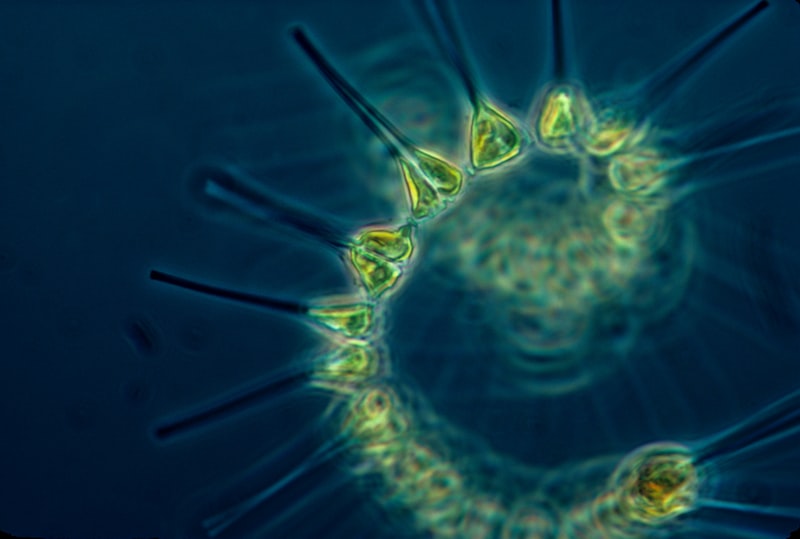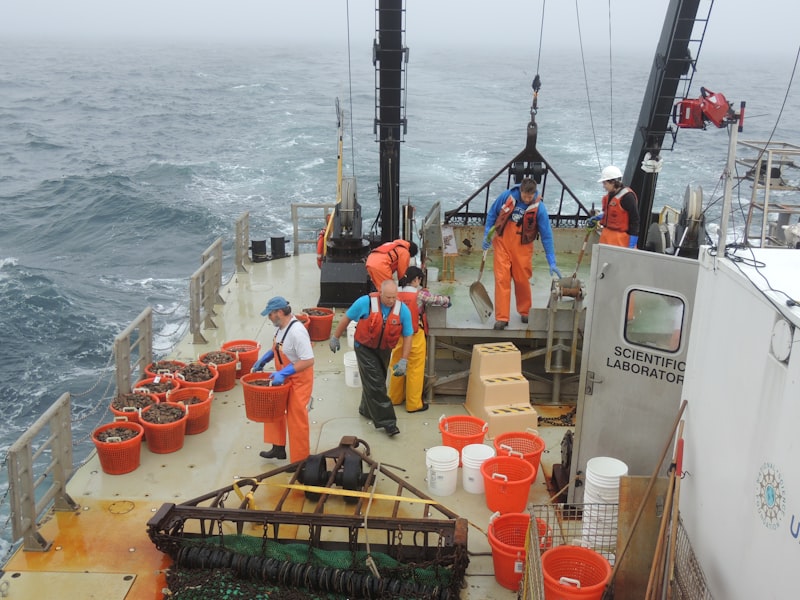Marine viruses, unlike their counterparts in terrestrial environments, have evolved unique adaptations to thrive in the salty embrace of the sea. They are incredibly diverse, with a multitude of types each tailored to target specific organisms within marine communities. From bacteria to phytoplankton, no marine inhabitant is immune to their influence.
One of the most fascinating aspects of marine viruses is their sheer abundance. In every drop of seawater, countless viral particles swim, ready to infect and replicate within their hosts. This abundance not only underscores their ecological importance but also highlights their role in nutrient cycling and genetic diversity.
Despite their omnipresence, marine viruses operate largely unseen and unrecognized. Yet, their impact resonates throughout the marine food web. By infecting and sometimes lysing their host cells, they release organic matter back into the water, fueling the growth of other organisms and contributing to the overall productivity of ocean ecosystems.
In a sense, marine viruses can be likened to silent orchestrators, conducting a symphony of interactions beneath the waves. They shape the dynamics of marine communities, influencing everything from population sizes to the genetic makeup of species. Their role in marine ecology is not just pivotal but essential, revealing a complex web of relationships that sustain life in our oceans.
As scientists delve deeper into understanding marine viruses, they uncover new layers of complexity and marvel at the intricacies of this hidden world. Each discovery sheds light on how these tiny agents of change sculpt the marine environment, prompting us to rethink our perception of life beneath the surface.
Unveiling the Ocean’s Secrets: Exploring the Enigmatic Realm of Marine Viruses
Imagine these viruses as invisible architects, shaping the balance of oceanic biodiversity. They act as regulators, controlling the populations of marine organisms by infecting and sometimes even altering their hosts. In doing so, they influence nutrient cycling and energy flow, essential processes that sustain life in the vast blue expanse.
One might wonder: How do these viruses proliferate in such a vast and dynamic environment? Like silent predators, marine viruses replicate within their hosts, sometimes leading to the collapse of bacterial populations, a phenomenon crucial for nutrient recycling. Their role in the “microbial loop” ensures that organic matter remains in circulation, benefiting all levels of the marine food web.
Intriguingly, marine viruses are not merely agents of destruction but also catalysts for genetic diversity. Through horizontal gene transfer, they shuttle genetic material between different species, fostering adaptation and evolution among marine organisms. This genetic exchange is akin to a cosmic dance of information, where even the smallest entities contribute to the resilience and adaptation of marine life forms.
As we peel back the layers of the ocean’s secrets, the study of marine viruses emerges as a frontier of scientific discovery. Researchers delve deeper, employing advanced genomic techniques and ecological models to unravel the complexities of these unseen forces. Each discovery adds a new piece to the puzzle of marine virology, shedding light on how these tiny entities shape the resilience and health of our oceans.
In this vast realm where the mysteries of life intertwine, marine viruses stand as both guardians and agents of change, highlighting the interconnectedness of all life forms in the oceanic web of existence.
The Microscopic Giants: Understanding the Impact of Marine Viruses on Ocean Ecosystems
Marine viruses are abundant and diverse, outnumbering even bacteria by a factor of ten in every drop of seawater. Despite their diminutive size, they possess the power to influence the entire food web of the ocean. Their primary targets are bacteria and phytoplankton, crucial components of marine life. By infecting and sometimes killing these microorganisms, marine viruses regulate their populations and nutrient cycles.

One of the most fascinating aspects of marine viruses is their ability to act as genetic architects. Through a process called horizontal gene transfer, viruses can transfer genetic material between different organisms, potentially influencing their evolution. This unique capability raises intriguing questions about the interconnectedness of life in the ocean and the adaptability of marine species in response to environmental changes.
Furthermore, marine viruses play a significant role in global biogeochemical cycles. When they infect and lyse bacterial cells, organic matter is released back into the water, making nutrients available for other organisms. This process, known as viral shunt, enhances nutrient recycling and supports the productivity of marine ecosystems.
While their impact is profound, marine viruses remain a relatively understudied area of marine science. Researchers continue to explore their diversity, ecological roles, and potential applications in biotechnology and environmental management. Understanding these microscopic giants is not only crucial for marine ecology but also offers insights into the fundamental processes that sustain life on Earth.
Marine viruses, despite their size, wield immense influence over ocean ecosystems. Their ability to shape microbial communities, influence nutrient cycles, and potentially drive evolutionary change underscores their importance in the complex web of marine life. As scientists delve deeper into their mysteries, we uncover more about the intricate workings of our oceans and the delicate balance that sustains them.
Invisible Architects of the Sea: How Marine Viruses Shape Aquatic Life
In the vast expanse of the ocean, where life seems serene and expansive, a hidden force plays a crucial role in shaping its delicate balance: marine viruses. These microscopic entities, often overlooked, are the invisible architects of the sea, wielding significant influence over aquatic ecosystems.
Marine viruses are abundant, outnumbering even bacteria in the ocean. Despite their small size, they hold immense power in regulating the population dynamics of marine organisms. They infect a wide range of hosts, from bacteria to larger creatures like algae and phytoplankton, thereby influencing the entire food web.
One of their key roles lies in controlling bacterial populations. By infecting bacteria, marine viruses help maintain ecological balance by preventing bacterial overgrowth, which could otherwise lead to harmful algal blooms or oxygen-depleted dead zones. In this way, they act as natural regulators of nutrient cycles and ecosystem health.
Moreover, marine viruses play a crucial role in shaping genetic diversity in marine environments. Through a process known as horizontal gene transfer, viruses can transfer genetic material between different species of marine microorganisms. This mechanism not only enhances genetic diversity but also drives evolutionary adaptations, allowing marine life to better respond to environmental changes over time.
Interestingly, marine viruses are also intertwined with climate regulation. They influence the carbon cycle by affecting the life and death of marine organisms. When infected, phytoplankton and other microorganisms release organic matter into the ocean, which can either sink to the deep sea or be consumed by other organisms. This process impacts the amount of carbon dioxide absorbed or released into the atmosphere, thereby influencing global climate patterns.

While often unseen and unnoticed, marine viruses are pivotal players in the intricate web of life within our oceans. They contribute significantly to nutrient cycling, genetic diversity, and climate regulation, highlighting their indispensable role as the invisible architects of the sea.
This article aims to capture the essence of how marine viruses influence aquatic life in a conversational and engaging style, using analogies and metaphors to enhance readability and understanding.
From Depths to Discovery: Delving into the Unseen World of Marine Viruses
Marine viruses are tiny entities that inhabit the ocean in unimaginable numbers, outnumbering even bacteria by an astonishing margin. Despite their minuscule size, they play a significant role in marine ecosystems, influencing everything from nutrient cycling to the evolution of marine organisms.
At the heart of their existence is their impact on marine bacteria. Marine viruses are known for infecting and sometimes killing bacteria in a process called lysis. This interaction not only regulates bacterial populations but also releases nutrients back into the ocean, fueling the marine food web. In a way, they act as the unseen architects of oceanic health, maintaining a delicate balance that supports life beneath the waves.
What makes marine viruses particularly intriguing is their incredible diversity and adaptability. Researchers have discovered that these viruses come in various shapes and sizes, each adapted to target specific hosts in the complex microbial communities of the ocean. Some marine viruses have evolved to be highly specialized, while others exhibit a broader range of hosts they can infect.
Their role extends beyond mere biological interactions; marine viruses also have implications for global processes such as carbon cycling. When marine organisms die, viruses facilitate the breakdown of organic matter, releasing carbon dioxide back into the atmosphere or sequestering it deep within the ocean floor.
Studying marine viruses requires advanced technologies and innovative approaches due to their microscopic size and elusive nature. Researchers employ techniques like metagenomics to unravel the genetic diversity of these viruses and understand their ecological impacts better. By exploring these unseen worlds, scientists gain insights that could potentially inform strategies for environmental conservation and management.
Guardians of Ocean Health: Marine Viruses’ Role in Balancing Aquatic Ecosystems
Marine viruses, unlike their counterparts in terrestrial environments, primarily infect marine bacteria and phytoplankton. This unique specialization forms the cornerstone of their ecological importance. By controlling the populations of these microorganisms, viruses help regulate nutrient cycles and maintain the delicate equilibrium of marine ecosystems.
Think of marine viruses as nature’s recyclers. When they infect and lyse bacteria and phytoplankton cells, they release organic matter back into the water. This process, known as viral lysis, enriches the surrounding environment with essential nutrients like nitrogen and phosphorus, which are vital for the growth of marine life forms higher up the food chain.
Furthermore, marine viruses influence global biogeochemical cycles by impacting the carbon cycle. Through viral lysis, carbon stored within microbial cells is released and can either be consumed by other organisms or returned to the atmosphere as carbon dioxide. This interplay between viruses and carbon underscores their critical role in climate regulation and the overall health of our planet’s oceans.
But it’s not just about numbers and cycles. Marine viruses also contribute to genetic diversity among microbial populations. Their ability to transfer genetic material between different hosts through processes like transduction facilitates adaptation and evolution in marine microbes, enhancing their resilience to environmental changes.
Beyond Bacteria: Marine Viruses’ Surprising Influence on Global Carbon Cycles
Imagine the vastness of the ocean as a grand theater, where bacteria are the main actors. They consume organic matter, a crucial step in the carbon cycle. However, their unchecked growth could lead to rampant decomposition, potentially releasing too much carbon dioxide back into the atmosphere.
Enter marine viruses, the silent conductors behind the scenes. They infect and control bacterial populations, keeping their numbers in check. In doing so, viruses prevent excessive carbon release by maintaining a balance in the ecosystem. This regulatory role is akin to nature’s own checks and balances system, ensuring that carbon remains stored in biomass rather than escaping into the atmosphere.
Moreover, marine viruses have another surprising trick up their sleeve—they facilitate genetic transfer among bacteria. Through a process called horizontal gene transfer, viruses can shuffle genetic material between bacterial cells. This mechanism enhances bacterial resilience and adaptation to environmental changes, thereby influencing the dynamics of carbon cycling on a global scale.
In essence, marine viruses are the unsung heroes of the ocean, orchestrating a delicate dance that affects not just marine life but the entire planet’s carbon balance. Their ability to modulate bacterial populations and enhance genetic diversity underscores their crucial role in maintaining ecological stability.
As scientists delve deeper into understanding these tiny yet powerful entities, their influence on global carbon cycles becomes increasingly evident. From regulating bacterial growth to promoting genetic diversity, marine viruses continue to surprise and amaze researchers, revealing new layers of complexity in the ocean’s intricate web of life.
Frequently Asked Questions
What role do marine viruses play in global biogeochemical cycles?
Marine viruses are integral in global biogeochemical cycles by controlling microbial populations, influencing nutrient cycling, and shaping ecosystem dynamics. They impact carbon fluxes through their role in the viral shunt, which releases organic matter back into the microbial loop. Understanding their interactions is crucial for comprehending marine ecosystem health and climate regulation.
How are marine viruses studied and detected?
Learn about the methods used to study and detect marine viruses, including filtration techniques, epifluorescence microscopy, and molecular approaches like PCR. These methods help researchers understand viral diversity, abundance, and ecological roles in marine ecosystems.
What are the implications of marine viruses for human health and industry?
Learn about the impact of marine viruses on human health and industry, exploring their potential implications and effects on marine ecosystems and commercial activities.
How do marine viruses impact marine ecosystems?
Learn about the impact of marine viruses on ecosystems, including their role in regulating microbial populations, nutrient cycling, and influencing global biogeochemical cycles.
What are marine viruses and why are they important?
Discover why marine viruses matter with our concise FAQ. Learn about their role in marine ecosystems, from regulating microbial populations to influencing nutrient cycles. Explore their impact on global climate and biodiversity, revealing their crucial significance in marine science.


